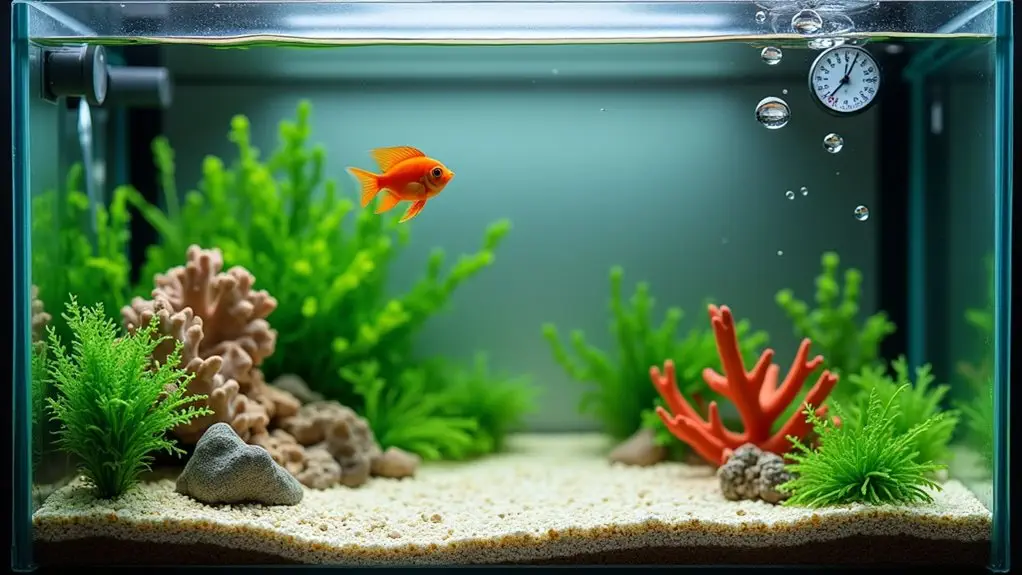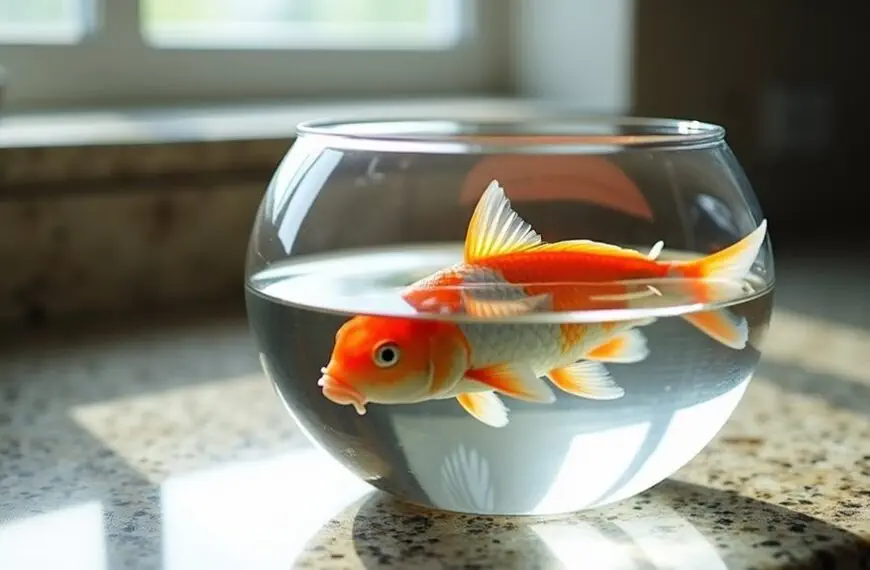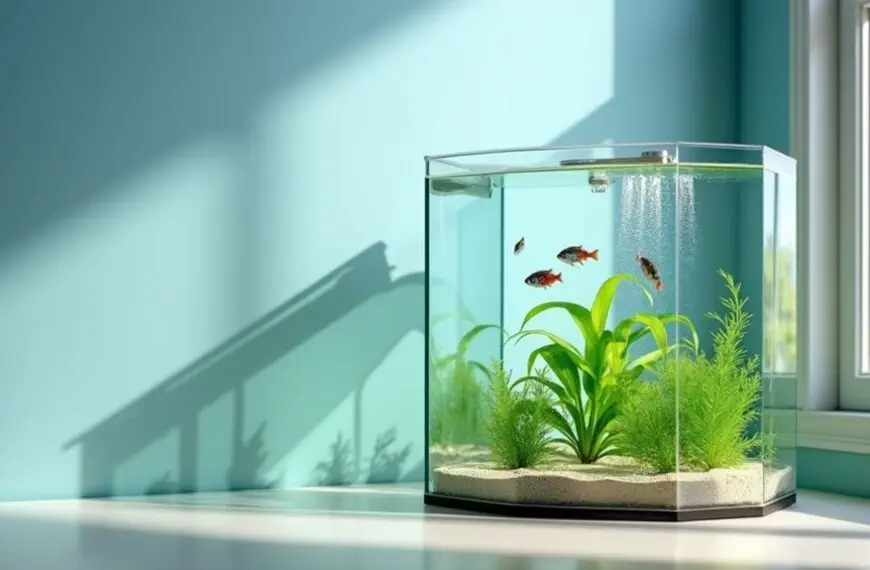Your fish tank's cleaning schedule depends mainly on its size. For tanks under 10 gallons, you'll need weekly cleanings, while larger tanks over 30 gallons can go 2-3 weeks between maintenance sessions. You should perform 10-15% water changes weekly, test water parameters regularly, and remove debris daily. Watch for signs that your tank needs attention, like cloudy water or sluggish fish behavior. Monthly deep cleans are essential, including a 25% water change and thorough decoration cleaning. Keep a maintenance log to track your tank's health – there's a lot more to keeping your aquatic friends happy and healthy.
Contents
- 1 Basic Fish Tank Maintenance Schedule
- 2 Signs Your Tank Needs Cleaning
- 3 Daily Care Requirements
- 4 Weekly Cleaning Tasks
- 5 Monthly Deep Clean Guide
- 6 Water Change Best Practices
- 7 Proper Filtration System Care
- 8 Tank Size and Cleaning Frequency
- 9 Seasonal Maintenance Tips
- 10 Professional Cleaning Services
- 11 Frequently Asked Questions
- 11.1 Can Cleaning the Tank Too Often Harm My Fish?
- 11.2 Should I Remove Fish From the Tank While Cleaning?
- 11.3 What Household Items Are Safe for Cleaning Aquarium Decorations?
- 11.4 How Do Medications Affect the Tank Cleaning Schedule?
- 11.5 When Should I Replace the Substrate Instead of Just Cleaning It?
- 12 Final Thoughts
Basic Fish Tank Maintenance Schedule
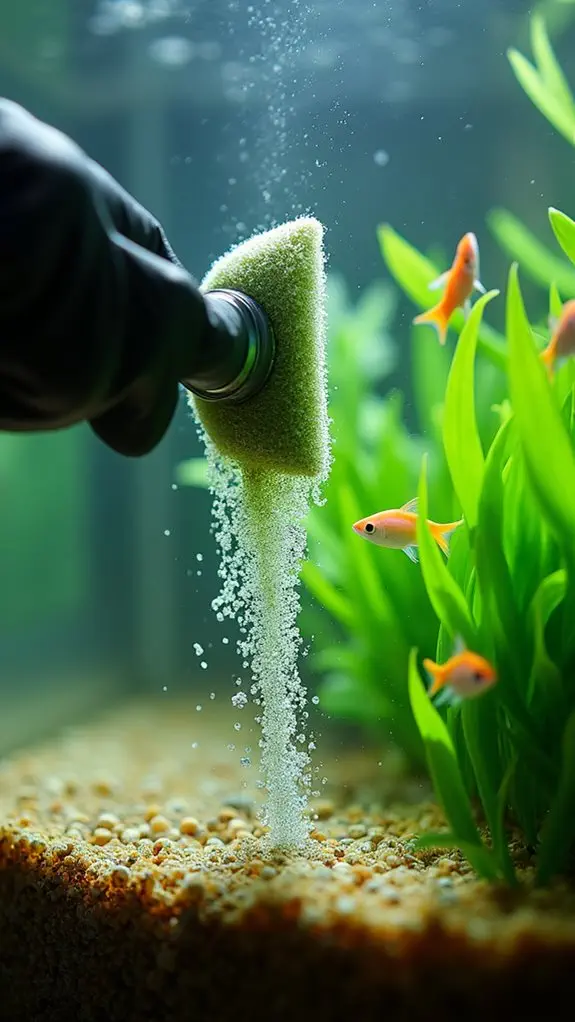
When it comes to maintaining a healthy aquarium, following a consistent cleaning schedule is essential for your fish's well-being.
A well-planned fish tank maintenance schedule keeps your underwater friends happy and your aquarium looking spectacular. For heavily stocked tanks with one fish per gallon, more frequent maintenance may be required.
You'll need to tackle some tasks weekly, like testing water parameters and performing 10-15% water changes to keep those invisible nasties at bay. Regular monitoring helps maintain pH levels between 6.5 and 8.2 for optimal fish health and reduces toxic ammonia levels that can harm your fish.
Don't forget to give your tank's glass a good wipe with a magnet cleaner (it's like a mini underwater window washing session!) and vacuum that gravel to remove any unwanted fish souvenirs.
Every two weeks, you'll want to clean those filter sponges and check your chemical filtration media.
Monthly tasks include a deeper clean with a 25% water change and some thorough attention to your decorations – think of it as your tank's monthly spa day!
And just like any home, there are those "as-needed" moments when you'll need to address unexpected issues like algae blooms or equipment troubles.
Signs Your Tank Needs Cleaning
Knowing the right time to clean your aquarium goes beyond following a set schedule. Your tank will show clear indicators when it needs attention, and learning to recognize these signs helps you maintain ideal conditions for your aquatic friends.
Keep an eye on your water's appearance – if it's becoming cloudy or taking on a yellowish tint, that's your tank telling you it's time for a cleaning session. Small changes of 10% water volume performed every few days can help restore balance when dealing with water clarity issues. Consistently testing the water parameters can also help you gauge when a cleaning is truly necessary.
You'll also want to watch for algae growth on the walls and decorations, which can quickly transform your crystal-clear aquarium into a green jungle. Regular scraping maintenance with appropriate tools will prevent excessive buildup on tank surfaces.
When your filter starts running slower than usual or you notice debris collecting around the intake, these mechanical filtration issues are definitely tank indicators that shouldn't be ignored.
Your fish's behavior is another reliable gauge of cleaning frequency. If they're acting sluggish or showing signs of stress, check your water parameters immediately.
Rising nitrate levels above 20 ppm, unexpected pH changes, or the presence of ammonia are serious red flags.
Don't forget to inspect your equipment too – if you're seeing salt creep or mineral buildup on accessories, it's time to roll up those sleeves and get cleaning!
Daily Care Requirements
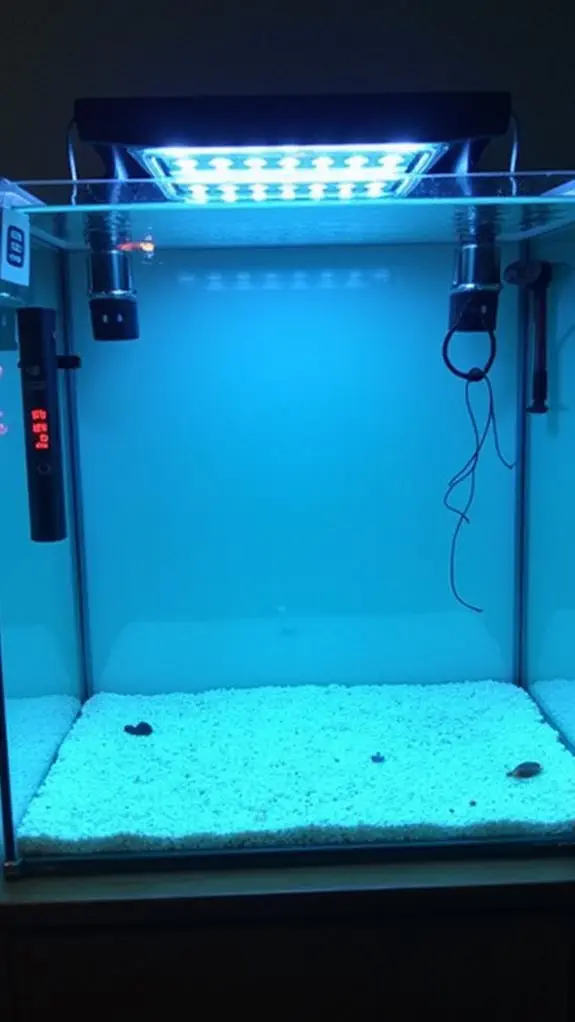
Consistency is the foundation of successful fish tank maintenance, and daily care routines keep your aquatic ecosystem thriving. You'll want to establish a daily checklist that covers essential tasks to maintain both fish behavior and tank aesthetics at their best. Deep cleaning tasks are rarely needed with proper daily maintenance.
Start each day by checking that all equipment is working properly – your pumps, filters, and lights should be humming along nicely. Keep an eye on your finned friends' behavior, as they're often the first indicators that something's not quite right. The ideal water temperature range for most freshwater fish is 75-80°F, so check this daily. Additionally, ensuring optimal conditions in terms of water quality reduces stress and promotes fish well-being.
You'll need to remove any uneaten food with a turkey baster (it's like a mini vacuum cleaner for your tank!) and top off water levels with treated water.
Monitor your water parameters daily using a testing kit – think of it as taking your tank's temperature. You wouldn't want your fish swimming in unsafe conditions!
Regular feeding is vital, but remember: it's better to underfeed than overfeed. Your fish should finish their meal within a couple of minutes, just like a well-timed lunch break.
Weekly Cleaning Tasks
You'll want to begin your weekly cleaning routine by checking those all-important water parameters, including pH, nitrites, and ammonia levels. Regular testing for nitrate levels is also crucial, as elevated spikes can stress your fish. Next, get your gravel vacuum in there to remove debris and uneaten food from the substrate, which will help maintain a healthier environment for your finned friends. Taking time to count all species during this cleaning helps ensure no fish are missing. Finally, don't forget to rinse your filter media in the old tank water you've collected, as this preserves those beneficial bacteria that keep your aquarium running smoothly. Replace about 15% to 20% of the water with fresh, dechlorinated water to maintain optimal conditions.
Test Water Parameters First
Before diving into your weekly tank cleaning routine, it's essential to test your aquarium's water parameters. You'll need a reliable water quality test kit to check important levels like ammonia, nitrates, and pH.
Think of it as giving your fish tank a quick health check-up – you wouldn't want to start cleaning without knowing what needs attention! Even small water changes can make a significant impact on water quality. Regular testing ensures that any fluctuations in ammonia, nitrite, and nitrate levels (which should be maintained at 0 ppm) are promptly addressed.
Testing frequency is important, and you should aim to test your water at least once a week. If you're noticing your fish acting unusual or the water looking cloudy, don't wait – test immediately.
Your API Master Test Kit or 5-in-1 test strips will become your best friends in maintaining a healthy aquarium environment.
When your test results show parameters outside the normal range, you'll need to take corrective action. This might include performing a partial water change, adding water conditioner, or boosting beneficial bacteria levels. The API STRESS ZYME can help maintain a healthy bacterial ecosystem in your tank.
Remember, cleaning without testing first can do more harm than good – you could accidentally disrupt your tank's delicate biological balance.
It's like trying to fix a car without checking what's wrong first. Always let your test results guide your cleaning routine for the happiest, healthiest fish possible.
Vacuum Substrate and Debris
A thorough substrate vacuum serves as the cornerstone of your weekly tank maintenance routine. Different substrate types require specific vacuum techniques, but the goal remains the same: removing fish waste, excess food, and plant debris before they can break down and affect your water quality.
You'll want to vacuum your tank once a week or every other week, depending on your setup. If you've got a planted tank, you'll need to be extra careful – those root systems can make vacuuming a bit trickier, but don't let that stop you! Work around your plants gently, and you'll get the hang of it.
For substrates deeper than two inches, you'll need to be especially thorough, inserting the vacuum tube carefully to allow debris to float up.
Remember to remove decorations before you start – there's nothing worse than trying to navigate around obstacles while playing "catch the debris!"
While you're vacuuming, you're also performing a partial water change, which is like hitting two fish with one stone (don't actually hit the fish, though!). Just be careful not to overdo it – you want to maintain that delicate balance of beneficial bacteria. Regular water changes help keep toxic ammonia levels at 0.0 ppm, ensuring a healthier environment for your fish.
Filter Media Maintenance
Filter media maintenance forms the backbone of your aquarium's health, requiring different cleaning approaches for mechanical, chemical, and biological components. Understanding the various filter media types and their specific needs will help you maintain crystal-clear water and happy fish.
- Mechanical media needs cleaning every 2-4 weeks to remove trapped debris.
- Chemical media (like activated carbon) requires replacement as effectiveness decreases.
- Biological media should rarely be cleaned to protect beneficial bacteria.
When it comes to media replacement frequency, you'll want to monitor each type carefully. Your mechanical filter media needs regular rinsing in old tank water – never tap water! – to remove debris while preserving those precious beneficial bacteria. Regular water tests, including checking ammonia and nitrite levels, will further ensure that your filter media is effectively supporting a healthy ecosystem.
For chemical media, you'll notice when it's time for a change as odors might become more noticeable or water clarity decreases. The biological media is your tank's MVP, so handle it with care and clean it only when heavily clogged.
Remember to set reminders for your maintenance schedule, and don't forget to adjust based on your tank's specific needs. If you're seeing cloudy water or noticing reduced flow, it might be time to check your filter media sooner rather than later.
Monthly Deep Clean Guide
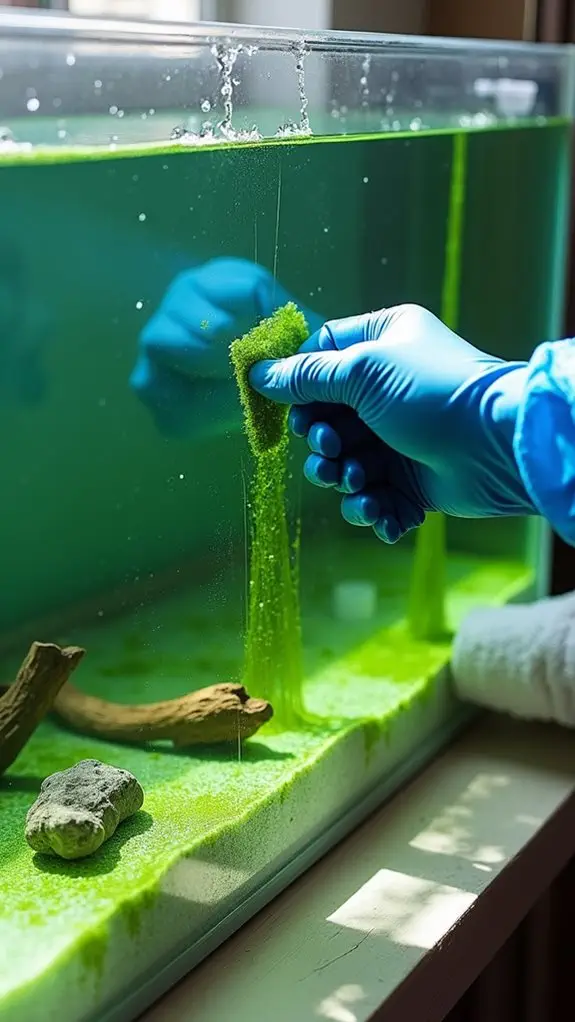
Performing a monthly deep clean of your aquarium requires careful planning and systematic execution to maintain a healthy environment for your fish. When you're ready to tackle this important maintenance task, start by unplugging all electrical equipment and removing 15-25% of the tank water.
During your deep cleaning session, you'll want to focus on thorough but gentle cleaning of all components. Clean your filters with treated water only – never use tap water or harsh chemicals that could harm your aquatic friends.
You can scrub decorations with hot water, but remember to avoid using unfiltered tap water that might introduce harmful chemicals to your tank.
Your monthly maintenance checklist should include inspecting and replacing equipment as needed. Check those air stones, tubing, and filter cartridges to verify everything's working properly.
Don't forget to clean the tank's exterior too – a dusty lid isn't exactly the window to aquatic paradise you're aiming for!
The best part? You can complete most deep cleaning tasks without removing your fish, as long as you're careful and methodical in your approach. Additionally, maintaining optimal pH levels is crucial for the well-being of your aquatic life during these cleaning sessions.
Just remember to maintain your regular daily and weekly maintenance routines between these deeper cleanings.
Water Change Best Practices
Before you grab that bucket for a water change, you'll want to test your aquarium's water parameters to understand exactly what you're working with.
Your test results will guide you on how much water to change, with nitrate levels being your most important indicator of when it's time for fresh water.
Getting into a habit of testing before water changes won't just keep your fish healthy – it'll help you develop a better understanding of your tank's unique patterns and needs. Additionally, managing nitrate levels is crucial for preventing stress in your fish and ensuring a balanced environment.
Proper Water Change Techniques
Regular water changes serve as the foundation of proper aquarium maintenance, but knowing how to perform them correctly is essential for your fish's health.
You'll want to focus on performing partial water changes of 20-50%, depending on your tank's specific needs and stocking levels.
Here are the key techniques you'll need to master:
- Always use a graded approach, starting with smaller changes and adjusting based on your tank's response
- Match the new water temperature to your tank to avoid shocking your fish
- Treat tap water with a conditioner before adding it to your aquarium
When you're performing water changes, aim to maintain consistent timing and volumes to keep stress levels low for your aquatic friends. Regular monitoring of water parameters is also crucial to ensure ongoing fish health.
You'll notice better water quality and healthier fish when you stick to a regular schedule. For most tanks, changing 30% of the water every two weeks works well, but you might need to adjust this based on your tank's bio-load.
Remember to monitor your water parameters after each change, and don't forget to clean your filter according to the manufacturer's recommendations – but never clean it with tap water, as this can harm beneficial bacteria.
Testing Before Water Changes
With any successful water change routine, proper testing serves as your first line of defense against potential problems.
Think of water testing as your aquarium's health checkup – it reveals invisible issues before they become serious problems for your finned friends.
You'll want to use reliable testing kits to monitor key parameters like ammonia, nitrite, nitrate, and pH levels.
For new tanks, test daily until the water stabilizes, then shift to every 2-4 weeks for established aquariums.
If you notice your fish acting strangely or spot a missing tank mate, it's time for an immediate full parameter check.
When your test results show high ammonia or nitrate levels, you'll need to perform a 30-40% water change – but don't go overboard!
Changes larger than 50% can stress your fish and upset those hardworking beneficial bacteria.
For regular maintenance, stick to 10-15% changes in established tanks.
Remember to keep a log of your test results; it's like maintaining a health diary for your underwater world.
This way, you'll quickly notice if something's off and can take action before small issues become big problems.
Proper Filtration System Care
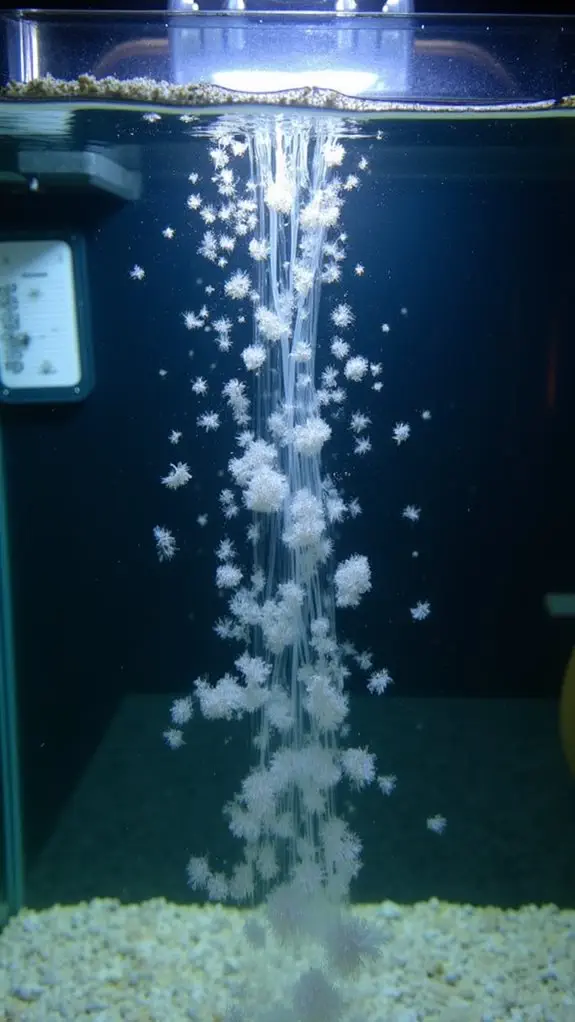
Your aquarium's filtration system serves as its essential life-support equipment, requiring specific maintenance to keep your fish healthy. Different filter types need varying levels of attention, from hang-on filters that need monthly cleaning to canister filters that can go 3-4 months between maintenance sessions.
To keep your system running smoothly, you'll want to establish a consistent cleaning schedule that works with your filter type.
- Never clean your filter with hot water or soap – these can kill beneficial bacteria
- Use old tank water to rinse filter media, preserving the good bacteria colony
- Keep a maintenance log to track when you've cleaned different filter components
When it comes to cleaning techniques, remember that less is often more. You don't want to over-clean your filter, as this can disrupt the biological balance in your tank.
Instead, focus on gentle cleaning methods using a soft brush for mechanical parts and careful rinsing of filter media. Make it a habit to check your filter's flow rate daily and inspect the inlet cage weekly.
If you notice reduced water movement or your plants aren't swaying as much as usual, it's probably time for some maintenance.
Tank Size and Cleaning Frequency
You'll find that bigger aquariums don't need cleaning as often as smaller ones, thanks to their larger water volume and more stable environments.
If you've got a small tank under 10 gallons, you're looking at weekly cleanings to keep your finned friends healthy and happy.
On the flip side, larger tanks over 30 gallons can often go 2-3 weeks between cleanings while maintaining good water quality, though you'll still need to keep an eye on those water parameters.
Bigger Tanks Need Less
Size plays an essential role in determining how often you'll need to clean your aquarium. When it comes to tank size, bigger really is better, and you'll be glad to know that larger tanks actually require less frequent cleaning. This is because they've got more water volume to dilute waste and maintain stable conditions.
- A bigger tank provides more space for beneficial bacteria to thrive, enhancing natural filtration.
- Larger water volumes help minimize sudden changes in water chemistry.
- More room means better waste management and improved cleaning efficiency.
You'll find that a larger aquarium's filtration effectiveness is remarkably better than smaller tanks. While you'll still need to perform regular maintenance, you won't have to clean as intensively or frequently.
Your bigger tank will naturally develop a more stable ecosystem, where waste management becomes more efficient through biological filtration and natural processes. Instead of weekly deep cleanings, you might only need to do 10-15% water changes every couple of weeks, depending on your tank's specific setup and inhabitants.
Remember to monitor your water parameters regularly – this'll help you determine when it's actually time for a cleaning session.
Small Tank Maintenance Demands
Small aquariums demand vigilant maintenance due to their limited water volume and reduced ability to dilute waste.
You'll need to stay on top of water quality by performing weekly or bi-weekly cleanings, which includes siphoning the gravel and changing 10-15% of the water. Think of your small tank like a tiny apartment – it gets messy faster than a mansion!
To maintain tank stability, you'll want to monitor water chemistry regularly and keep an eye on fish behavior, as these are excellent indicators of when it's time to clean.
Don't forget about algae control – using an appropriate scraper on the glass and decorations will keep your tank looking sharp.
Your filtration system is working hard to manage waste and maintain beneficial bacteria, so clean it carefully during maintenance.
If you've got live plants, they're great helpers in keeping water conditions cleaner, but don't let this make you complacent.
Remember, what seems like a small change in a larger tank can have a big impact in your compact aquatic world.
Keep your cleaning routine consistent, and your finned friends will thank you with their vibrant activity and healthy appearance.
Seasonal Maintenance Tips
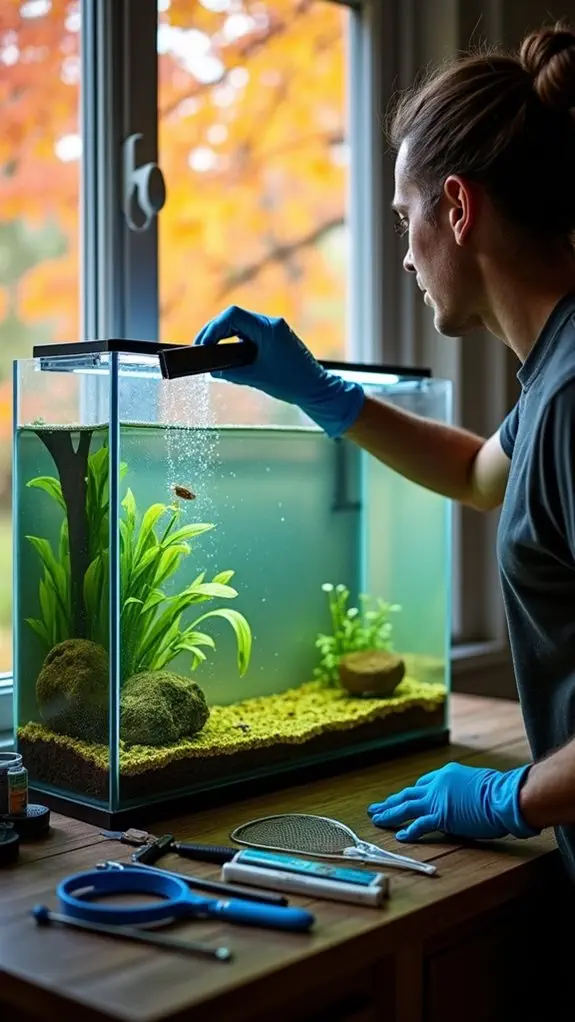
A successful aquarium requires different maintenance approaches throughout the year to keep your fish healthy and thriving. Your seasonal aquarium checklist should adapt to changing conditions, from summer's algae battles to winter's temperature challenges.
Here's why following seasonal tips matters for your underwater friends:
- Fish are sensitive to seasonal changes, even indoors
- Different seasons bring unique challenges to water quality
- Maintenance routines need adjustment as seasons shift
During spring, you'll want to kickstart the year with a thorough cleaning and equipment check.
When summer arrives, it's all about managing temperature and controlling those pesky algae blooms – nobody wants a green tank!
Fall is your prep time for winter, so you'll need to guarantee your heating system's ready for the colder months ahead.
In winter, you'll focus on maintaining stable temperatures and boosting your fish's immunity.
Professional Cleaning Services
Professional aquarium cleaning services step in when you need expert hands to maintain your fish tank's delicate ecosystem.
These experts bring professional expertise and specialized equipment to guarantee your aquarium health stays ideal, performing tasks you might find challenging or time-consuming on your own.
When you hire a cleaning service, you'll typically choose between basic maintenance, which includes water testing and changes, or deep cleaning that covers every component of your tank.
They'll start by carefully preparing your tank, turning off equipment, and conducting thorough water tests to check important parameters like ammonia and pH levels.
You'll appreciate how they methodically vacuum the gravel and remove those stubborn algae spots you've been eyeing.
What's great about professional services is that they'll work around your schedule, offering weekly or bi-weekly visits based on your tank's needs.
They'll even provide emergency services if you're facing a crisis!
Plus, you won't have to worry about maintaining expensive equipment or keeping track of cleaning schedules – they'll handle it all while sharing their knowledge to help you better understand your aquatic pets' needs.
Frequently Asked Questions
Can Cleaning the Tank Too Often Harm My Fish?
Yes, if you clean your tank too frequently, you'll remove beneficial bacteria and cause fish stress. Your aquarium needs a stable environment, and over-cleaning disrupts the natural balance your fish depend on.
Should I Remove Fish From the Tank While Cleaning?
You shouldn't remove your fish while cleaning – it causes unnecessary fish stress. Instead, use proper cleaning techniques like a gravel siphon with them in the tank. Only remove fish if there's toxic hydrogen sulfide present.
What Household Items Are Safe for Cleaning Aquarium Decorations?
You can safely clean aquarium decorations using a soft toothbrush, algae pad, or unused sponge. For cleaning solutions, stick to warm freshwater or a diluted bleach solution, avoiding household soaps and detergents.
How Do Medications Affect the Tank Cleaning Schedule?
You'll need to adjust your cleaning schedule based on medication types, as they'll increase waste and toxins. You should perform daily partial water changes during treatment and thoroughly clean the tank after medication's complete.
When Should I Replace the Substrate Instead of Just Cleaning It?
You'll need to replace your substrate when it's breaking down, causing poor tank health, or if you notice foul odors. Different substrate types have varying lifespans, but replace immediately if ammonia levels remain high.
Final Thoughts
You'll find that maintaining your fish tank isn't as intimidating as it might seem. By following a regular cleaning schedule – daily checks, weekly water changes, and monthly deep cleans – you're giving your aquatic friends the best home possible. Remember, every tank is unique, so you'll need to adjust these guidelines based on your setup. With consistent care and attention, you'll enjoy a crystal-clear tank and happy, healthy fish for years to come.

